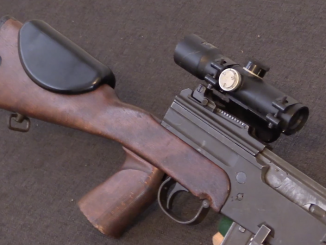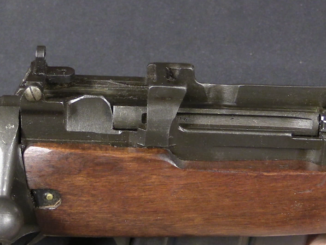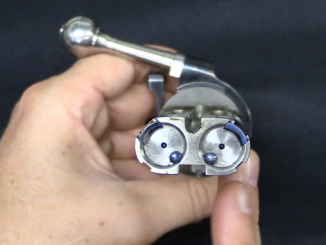Project Lightening is a collaborative series with Othais and Mae of C&Rsenal in which we test all seven light machine guns and automatic rifles of World War One and put them through a series of tests and evaluations. Each week we will be posting one video on Forgotten Weapons and one on C&Rsenal. Today we have the final conclusions, with a series blooper reel posted right now over on C&Rsenal:
Want to keep a copy of the entire series for yourself? You can download the entire series right now to keep for just $6.




Any particular reason C&Rsenal doesn’t have episode 6 listed on their web page? I think that was the total damage one, but I don’t see it listed.
Half the episodes were released on each channel.
I think what we have here is the start of a whole new channel.
Here are some facts:
Walking fire (actually call “Marching Fire” was discontinued by the US as a tactic by the end of August 1918. Therefore the BAR’s were not one to be seen using that tactic.
All these guns were team fired weapons. Individual use was a last resort when everyone else was killed or wounded. Chauchats used an immediate team of three, MG 08/15’s more than that. Chauchats were loaded by an assistant, the gunner only released the mag release when informed by the team member the mag was empty. The gunner could keep his view downrange at all times, not have to fiddle with magazines. Madsens had at least a team of two, with gunner/loader (there is a cool Danish movie showing Danes fighting Germans with a Madsen at the start of WWII when the Germans moved it…although in WWI they were not generally used in front line operations. There were just not many Madsens, the Danes were all caught up in this neutrality thingy.
Walking/Marching fire when used had the gunner in a bent over position when in action (this made a smaller target).
These guns were all equipped with slings that had combat use. Although Marching fire was a semi-obsolete tactic, the guns had to consider standing usuage to due tactical situations….so they were ALL provided with slings. Slings took the weight of the gun when times required the guns to be used in action, the hands of the gunner were used to help CONTROL and point the weapon,not hold it up in the air, which is why I did not understand the walking fire episode at all. When walking or prone a loader was also changing the mags.
The MG 08/15 was a heavy pig although it’s overall firepower was overwhelming. 100 round drums were the norm for standing shooting, but as soon as it went to ground the assistants were loading 250 round belts. So in a situation of prone shooting, especially if covering or dealing with a counterattack, the belts were used (that is where the water cooling came in handy).
Even the early US manual on the Chauchat suggested 18 rounds instead of twenty for increased reliability. I don’t know how many rounds they were using but when the guns ran out a loader put in another….so in the firing test the firepower of the Chauchats was greater than project lightening was doing.
Well, I think the Hotchkiss would have been more fairly judged if it had, 1, an assistant loader, correct steel stripper clips, not the japanese brass ones, and a bipod. See the end of the bipod, it had the provision. The bipod was the standard mount for the 19099 Hotchkiss EXCEPT for British Cavalry which used that nasty little tripod, which was crappy just like most cavalry was in WWI. See the US use of the 1909 Hotchkiss with BIPOD. The only picture I know of Brit infantry using Hotchkiss were Indians/Sikhs? using one WITH A BIPOD.
The Lewis gun was great, there is no way of getting round it, but it was HEAVY and that limited it’s use on offense (although not near as heavy as the Mg 08/15).
This entire exercise was a comparison of apples and oranges, that is incomplete apples and oranges. Great fun, but hardly informative. In short, the guns seen for use in actual numbers were the Chauchats (the 1918 discarded as almost as soon as reaching the front), the Lewis, the MG 08/15’s, and the BAR’s at the end of the war.
I call for a REMATCH with proper slings and assistant gunners..and the O8/15 with the bipod in the correct position! Ok, Lewis gun still wins (except portability–which was a big deal).
Yeah, the Lewis isn’t great for firing from a standing position. I doubt anyone could hold it up, let alone dump a magazine down range from a standing position out of the trenches. The cooling shroud would get hot eventually and burn your off-hand! And for why we can’t get more: Lewis charged a hefty licensing fee. It cost at least £130 (1914 currency) for a single gun after manufacturing costs without even adding the cost for spare parts and magazines. Did I mess up?
“doubt”
Then see image A Device for the Lewis Gun Allowing It to be Fired from the Shoulder with Ease. https://www.ibiblio.org/hyperwar/USN/ref/MG/I/img/MG-1-257-16.jpg from https://www.ibiblio.org/hyperwar/USN/ref/MG/I/MG-4.html
To say that this show is not informative is frankly ridiculous. There isn’t any direct comparison of all these guns ever before. As a direct comparison of the innate handling and shooting qualities, the show have done a great job.
Of course it is unfortunate that this example of the Hotchkiss comes with this shitty tripod but the actual shooting performance isn’t that bad at all.
When considering the crew aspect, there is simply no way to compare them fairly. How can you compare a 08/15 with 4 man crew with a bar carried by one guy (I would argue that for BAR and Chauchat the bottom fed mag suggested it doesn’t gain much with an assistant gunner on reload)
I do agree that walking fire is pointless and BAR or Madsen will be the best on the move since they can be reasonably shoulder fired. (Chauchat is doable, Lewis is possible)
And complaining about the bipod direction of 08/15 is pointless the bipod is located at the center in either direction, the muzzle is going to climb, period.
It is quite easy to predict what kind of result your desired version of the test would be thanks to the information from this series.
Lewis will just pull off more from the
rest thanks to quicker reload and portability with sling. With the cooling shroud and heat sink, it can also fire more rounds continuously then anything except 08/15. (quick change barrel did exist yet)
Madsen do a bit better since top mount mag is good for reloading by asst. gunner. Still bias to semi auto though
08/15 gets better reload and can fire continuously, but rounds down range is still isn’t as effective. It is still not that portable.
BAR and Chauchat really does not gain much, but hey, they and the Madsen can go through a 2 gun course while others can’t.
If continues fire is considered Chauchat will just fail hard with the barrel stuck aften 100~200 rounds
Hotchkiss with bipod and crew will do quite well, but is still awkward to carry, doesn’t have any cooling measures, need someone to keep hooking
and supporting new strip and probably not the most accurate.
Unlike developers of these weapon, we know further evolution.
Regarding fed system: We today know that Hotchkiss-style tray-fed become extinct relatively quickly in light machine gun. Belt fed would not become common until general-purpose machine gun. Magazine fed would remain most popular, however greatly varying in direction (upward/downward/sideward) and also form (box/pan/drum).
“water cooling”
Interestingly, Austrian-Hungarian “medium machine gun turned into light[er]” also remained water-cooled, see drawing: http://ww1.milua.org/shvarzloze07-ruch.htm
unlike German one, Schwarzlose is delayed blow-back weapon with fixed barrel, meaning that deleting water cooling is much easier, as their is no need to support barrel.
Thank you so much for Project Lightening. Despite whatever limitations were inherent of the project, it still developed some good information and insights into the nature of the guns and tactics.
I found episode 6 of the series, “total damage”, as the most surprising. The limitations of automatic fire even at such point blank range was eye opening. And it inspired me to an epiphany about the French Mdle 24/29 LMG odd dual trigger mechanism.
Using full auto bursts to find the range to a new target could waste most of the magazine before the target is fully engaged. So Perhaps the semi-auto trigger of the 24/29 was intended for use in ranging a target before cutting loose with a full auto burst of fire. This could be done very rapidly with the dual trigger mechanism, since after a few ranging shots in semi-auto the gunner could instantly deliver a full auto burst without changing his grip or sight alignment. Loading the first 2 to 5 rounds fed from the magazine with tracer ammo could aid such a tactic.
every time i click on episode 7, episode 8 comes up. getting frustrated.
Try this link for the Forgotten Weapons YouTube channel…
https://www.youtube.com/watch?v=TNJo0w43Wjc&feature=youtu.be